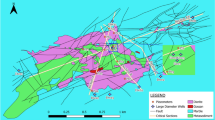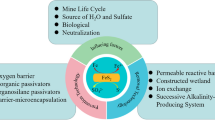Abstract
Hierakonpolis, Greek for City of the Hawk, nearly 25 km NW of Idfu (Egypt), is an important and extensive archaeological discovery covering a large area. Its richness in archaeological artifacts makes it a valuable site. It has a valid claim to be the first nation state, as indicated by the Palette of Narmer discovered in its main mound. Geological and hydrogeological investigations at the Hierakonpolis Temple Town site documented nearly a 4.0-m water table rise from as early as 1892 to the present. In addition to the rising water levels, the increase of both subsoil water salinity and humidity threatens and damages fragile carvings and paintings within tombs in Kingdom Hill, the foundation stability of the site, and the known and still to be discovered artifact that recent pottery finds dates at least 4,000 BCE. Representative rock and soil samples obtained from drilled cores in the study area were chosen for conducting detailed grain size and X-ray analysis, light and heavy mineral occurrences, distribution of moisture and total organic matter, and scanning electron microscopy investigations. Mineralogical analysis of clays indicated that the soil samples are composed of smectite/illite mixed layers with varying proportions of smectite to illite. Kaolinite is the second dominant clay constituent, besides occasional chlorite. Swelling of the clay portion of the soil, due to the presence of capillary groundwater, in contact with buried mudbrick walls expands and causes severe damage to important exposed and buried mudbrick structures, including the massive ancient “fort” believed to date from the Second Dynasty (from 2,890 to 2,686 BC). The “fort” is 1.0 km south of the Temple Town mounds near to confluence of Wadi Abu Sufian. Groundwater samples from the shallow aquifer close by the intersection of Wadi Abu Sufian and the Nile flood plain were analyzed for chemical composition and stable isotope ratios. The groundwater in the upper zone (subsoil water) within fine-grained Nile alluvium is characterized by high salinity which varies from 415 to 4,500 mg/L total dissolved solids. In contrast, most of the groundwater samples in the lower zone (Quaternary aquifer) are characterized by a low salinity in the order of 164–792 mg/L. Values of δD and δO18 obtained from this deep (9–20 m) aquifer ranged from 16.98 to 19.87 ‰ and from 1.67 to 2.99 ‰, respectively. These values indicated that the Quaternary aquifer waters are recharged directly from recent Nile water. Subsoil water is very shallow in the area; it ranged from 0 to 2.6 m with a mean of 1.1 m within the main mound of the Hierakonpolis Temple Town site by 2003, in contrast to its more than 4.5-m depth in 1897. The exposure of subsoil water to increased evaporation is expected, with a consequent increase in the concentrations of dissolved solids and usually large proportions of chloride and sulfate. Artifacts recovered from the Temple Town site are becoming damaged and destroyed by crystallization processes caused by repeated wetting and drying of salt and the accumulation of new salts.










Similar content being viewed by others
References
Abu Zeid, M. (1989). History and future role of water development and management in Egypt. In M. H. Amer & N. A. de Ridder (Eds.), Land drainage in Egypt (pp. 23–42). Cairo, Egypt: Drainage Research Institute (DRI). 377 pp.
Amoroso, G. G., & Fassina, V. (1983). Stone decay and conservation, atmospheric pollution, cleaning, consolidation and protection. Amsterdam: Elsevier. 453 pp.
Awad, M. A., Farid, M. S., & Hamza, M. S. (1994). Studies on the recharge of the aquifer systems in the southern portion of the Nile Delta by use of radioisotopes and hydrochemistry. Isotope and Radiation Research, 26(1), 21–25.
Awad, M. A., El-Arabi, N. E., & Hamza, M. S. (1997). Use of solute chemistry and isotopes to identify sources of groundwater recharge in the Nile aquifer system, Upper Egypt. Ground Water, 35(2), 223–228.
Bowler, G. K., & Winter, N. B. (1996). New form of salt staining on external masonry. British Ceramic Transactions, 95, 82–86.
Conoco Coral/The Egyptian General Petroleum Corporation. (1986). Geological map of Egypt. NG 36 SW Luxor, 1:500,000.
Coplen, T. (1993). Uses of environmental isotopes. In W. M. Alley (Ed.), Regional ground-water quality (pp. 227–254). New York: Van Nostrand Reinhold.
Craig, H. (1961). Standard for reporting concentration old deuterium and oxygen-18 in natural water. Science, 133, 1833.
El Hossary, M. (1994). Hydrogeological and hydrochemical studies on Luxor area, southern Egypt. MSc thesis, Faulty of Science, Ain Shams University, Cairo, Egypt.
El-Naggar, Z. R. M. (1970). On a proposed lithostratigraphy subdivision for the Late Cretaceous–Early Paleogene succession in the Nile Valley, Egypt. 7th Arab Petroleum Congress, Kuwait.
Folk, R. L., & Ward, W. C. (1957). Brazos River bar, a study in the significance of grain size parameters. Journal of Sedimentary Petrology, 27, 3–26.
Gleeson, B. (2002). The waters of the Nile. Online research, Penn State, vol. 23, issue 3. Retrieved http://www.rps.psu.edu/0209/nile.html. Accessed June 2010.
Hach. (1990). Chemical procedures explained. Colorado, USA: Hach Technical Center for Applied Analytical Chemistry. 48 pp.
Hawass, Z. (1995). Saving the monuments of Egypt. Minerva, 616, 6–11.
Kassab, A.S., & Mohamed, A.S. (1996) Upper Cretaceous macrofossils from the Duwi Formation of the Nile Valley, southern Egypt. Neues Jahrbuch fuer Geologie und Palaeontologie. Abhandlungen, 200(3):259–284.
Kerdany, M. T., & Cherif, O. H. (1990). Mesozoic. In R. Said (Ed.), The geology of Egypt, Chapter 22 (pp. 407–438). Rotterdam: Balkema.
Montandon, L. M. (2004). Use of remote sensing with ground truth and GIS to study the hydrological setting of the Hierakonpolis Archeological site in Egypt. Unpublished MS thesis, Department of Geosciences, The Pennsylvania State University, University Park, PA, 103 pp.
Moret, G. J. M., Parizek R.R., Gold D. P., El-Gohary A., Alexander S. S., Walters E. J., Parizek K. A. (2012). Modeling annual groundwater temperature variations at the Hierakonpolis Temple site. Bulletin Tethys Geological Society, Cairo, Egypt (in press).
Papagianni, I., & Theocharidou, K. (1993). Efflorescence tendency of mortars used in interventions on old masonry. In M. J. Thiel (Ed.), Conservation of stone and other materials (pp. 621–628). London: E and F.N Spon.
Parizek, R.R. (2001). Options for controlling groundwater at Edfu, Esna and other antiquities in the Nile Valley. White Paper submitted to Egyptian Antiquities Organization, Picard, Egypt, 37 pp.
Parizek, R. R. (2007). Reply to questions posed by the visiting delegation, Mudbrick “Fort”, Wadi Abu Sufian. Report submitted to the Supreme Council of Antiquities, Cairo, Egypt. Febraury 1, 2001, 51 pp.
Parizek, R. R., Gold, D. P., Walters, E. J., & Alexander, S. S. (1999). Characterization of an ancient Egyptian site through innovative seismic, geologic, archeologic and hydrogeologic methods. Abstracts with Programs. Annual Meeting of the Geological Society of America, Denver, CO, October 25–28, 1999, vol. 31, no. 7, A-412.
Parizek, R. R., El-Gohary, A., Parizek, K. A., Walters, E. J., Gold, D. P., & Alexander, S. S. (2005). Preservation of old mudbrick “fort” south of the Temple-Town Hierakonpolis Site, Wadi Abu Sufian, Egypt. Report submitted to the Supreme Council of Antiquities, Cairo, 28 pp.
Parizek, R. R., El-Gohary, A., Parizek, K. A., Gold, D. P., Alexander, S. S., Walters, E.J. (2006). Multidisciplinary hydrological investigations to assess and mitigate adverse consequences of large irrigation projects. Proceedings of the First International Conference on the Geology of the Tethys, Cairo University, Cairo, November 2005, vol. 2, pp. 533–552.
Picard, M. D. (1971). Classification of fine-grained sedimentary rocks. Journal of Sedimentary Petrology, 41, 179–195.
Piper, A. M. (1944). A graphic procedure in the geochemical interpretation of water analyses. Transaction American Geophysical Union, 25, 914–923.
Quibell, J., & Green, F. (1902). Hierakonpolis, vol. 11. London: Egyptian Exploration Society. 110 pp.
RIGW (Research Institute for Groundwater). (1997). Hydrogeological map of Egypt—Esna. Academy of Scientific Research and Technology (ASRT), Cairo, Egypt. Scale 1:100,000.
Rizzini, A., Vezzani, F., Cococcetta, V., & Milad, G. (1978). Stratigraphy and sedimentation of a Neogene–Quaternary section in the Nile Delta Area (A.R.E.). Marine Geology, 27, 327–348.
Sadek, M. A., & Abd El-Samie, S. G. (2001). Pollution vulnerability of the Quaternary aquifer near Cairo, Egypt, as indicated by isotopes and hydrochemistry. Hydrogeology Journal, 9, 273–281.
Said, R. (1981). The geological evolution of the River Nile. New York: Springer, 151 pp.
Sampsell, B. M. (2003). A traveler’s guide to the geology of Egypt. London: American University in Cairo Press. 228 pp.
Senosy, M. M., Felesteen, A. W., & Hamdan, A. (1998). Application of electrical resistivity method in ground water elevation of Wadi El-Sa’ayda area, northwest of Idfu. Egypt Bulletin of the Faculty of Science, Assiut University, 27(2-F), 121–145.
Velde, B. (1995). Composition and mineralogy of clay minerals. In B. Velde (Ed.), Origin and mineralogy of clays (pp. 8–42). New York: Springer.
Vites, H. A. (1993). Observation and explanations of stone decay in Oxford, U.K. In M. J. Thiel (Ed.), Conservation of stone and other materials (pp. 15–123). London: E and F.N Spon.
Wilson, M. D., & Pittman, E. D. (1977). Authigenic clays in sandstones: recognition and influence on reservoir properties and paleoenvironmental analysis. Journal of Sedimentary Research, 47, 3–31.
Winkler, E. M., & Wilhelm, E. J. (1970). Salt burst by hydration pressures in architectural stone in urban atmosphere. Geological Society of America Bulletin, 81, 567–572.
Wüst, R. A. J. (1998). Stratigraphy, regional geological evolution history and geotechnical analysis in the Thebes area, Luxor, Egypt: implications for archaeological investigations of ancient Egyptian constructions. Abstract, 48 Annual Conference of the American Research Center in Egypt (Los Angeles) April 23–26, pp. 69–70.
Wüst, R. A. J., & Mchane, J. (2000). Rock deformation in the Royal Tomb of Seti I in the Valley of the Kings, Luxor, Egypt. Engineering Geology, 58, 163–190.
Wüst, R. A. J., & Schlüchler, C. (2000). The origin of soluble salts in rocks of the Thebes Mountains, Egypt: the damage potential to ancient Egyptian wall art. Journal of Archaeological Sciences, 27, 1161–1172.
Zehander, K. (1993). New aspects of decay caused by crystallization of gypsum. In M. J. Thiel (Ed.), Conservation of stone and other materials (pp. 107–114). London: E and F.N Spon.
Acknowledgments
The Permanent Committee, Supreme Council of Antiquities, authorized hydrogeologic and related investigations at the Hierakonpolis Temple Town and the “ancient fort.” Support was provided through a US–Egypt joint NSF grant no. INT 01-11344 (period September 1, 2001–August 31, 2004), grant no. 01SE-04-20777 (period September 1, 2004–August 31, 2006), together with personal funds provided by E.J. Walters, R. Shoemaker, R.R. and E.B. Parizek. The Pennsylvania State University undergraduate and graduate students together with students from other institutions are acknowledged for their contributions during respective field seasons. K.A. Parizek and E.B. Parizek helped log cuttings, construct shallow piezometers, and collect water level and quality data related to this investigation. El Kom El-Ahmar villager Ahmed Bast assisted with augering and piezometer construction. Geology Department staff, Tanta University, performed chemical analysis, the Central Laboratory for Environmental Hydrology, Atomic Energy Authority (Cairo), provided isotopic analysis, and Emily Hartsay provided editorial assistance.
Author information
Authors and Affiliations
Corresponding author
Rights and permissions
About this article
Cite this article
El-Shishtawy, A.M., Atwia, M.G., El-Gohary, A. et al. Impact of soil and groundwater corrosion on the Hierakonpolis Temple Town archaeological site, Wadi Abu Sufian, Idfu, Egypt. Environ Monit Assess 185, 4491–4511 (2013). https://doi.org/10.1007/s10661-012-2884-6
Received:
Accepted:
Published:
Issue Date:
DOI: https://doi.org/10.1007/s10661-012-2884-6




